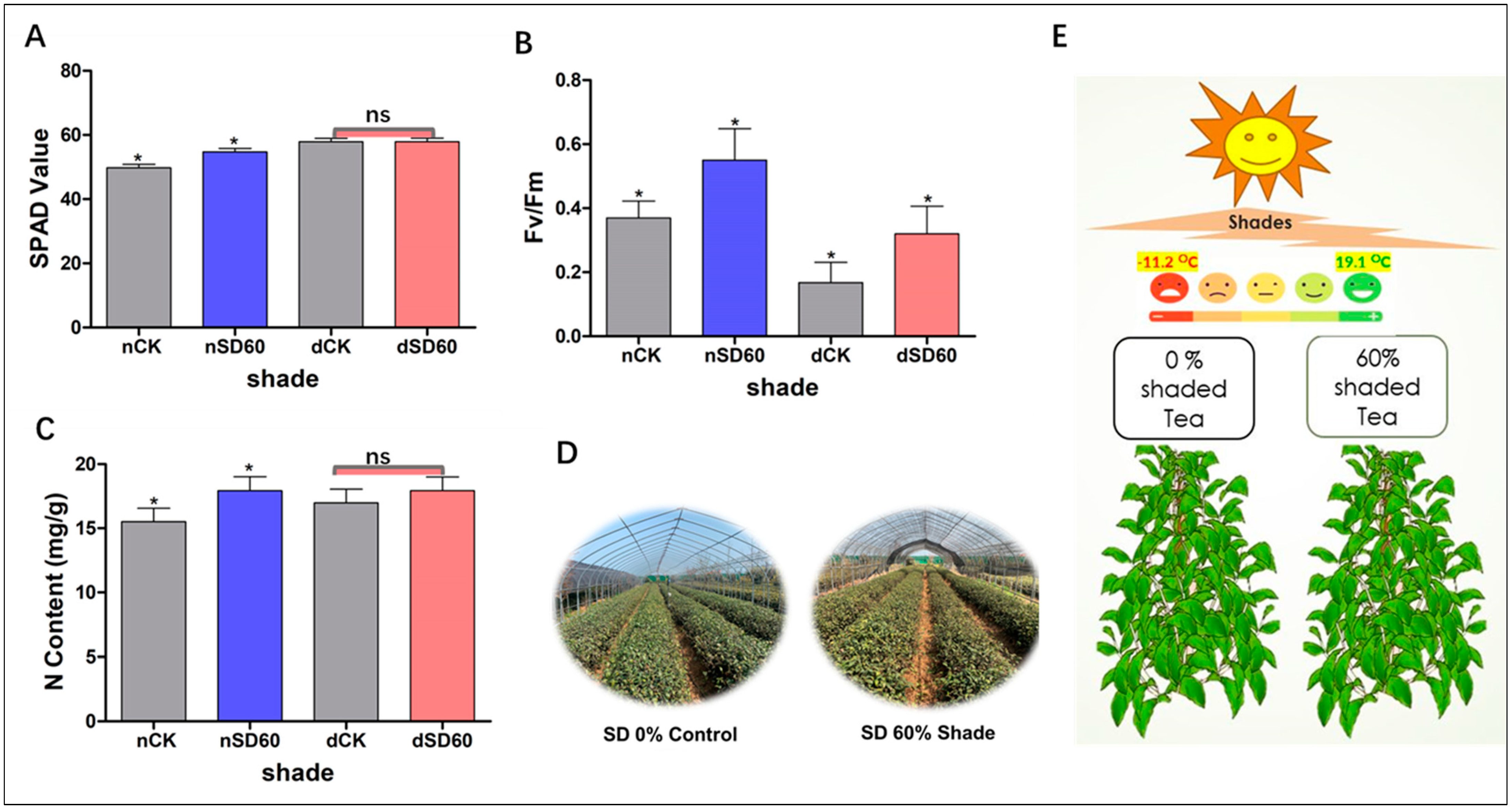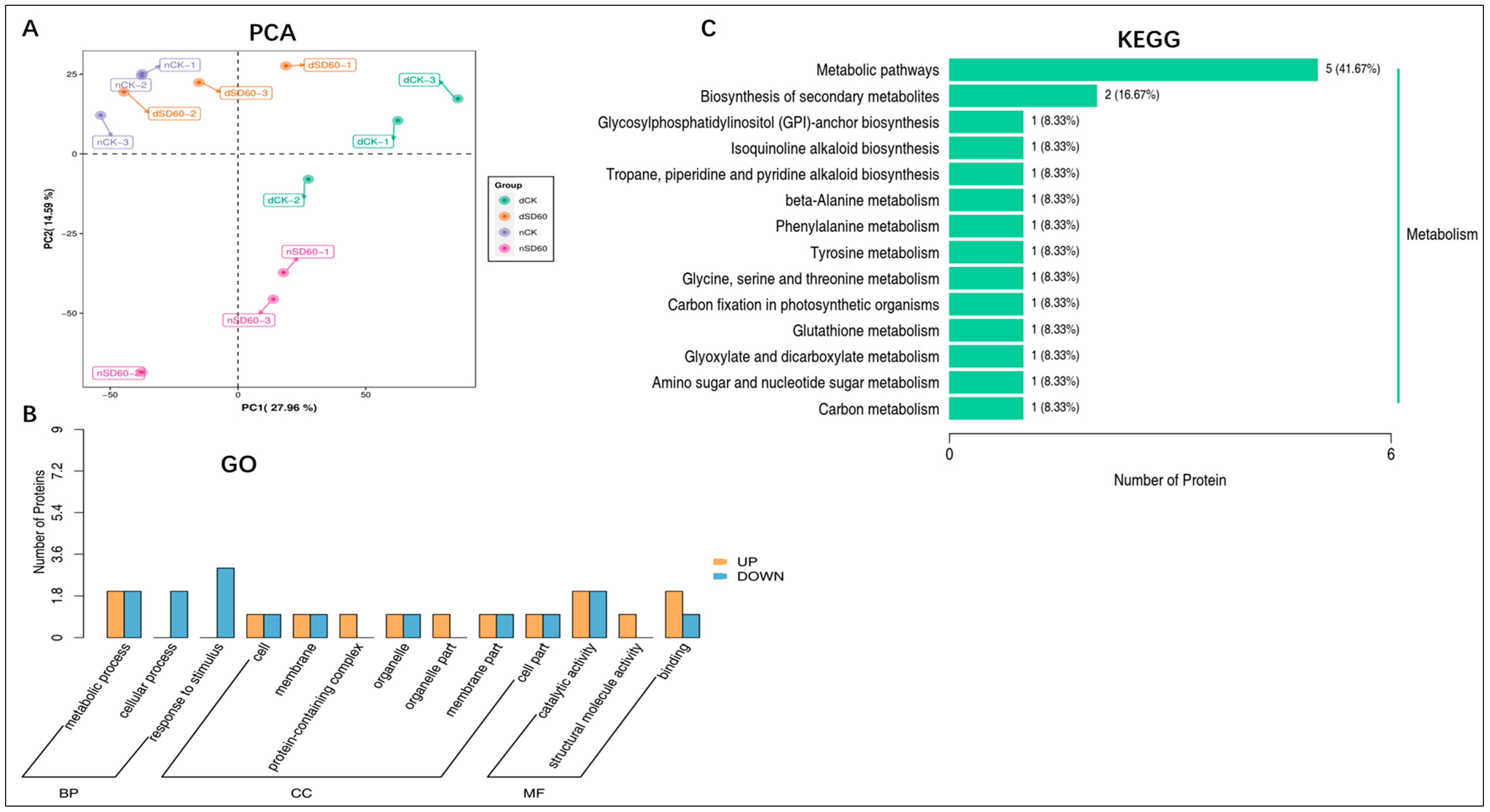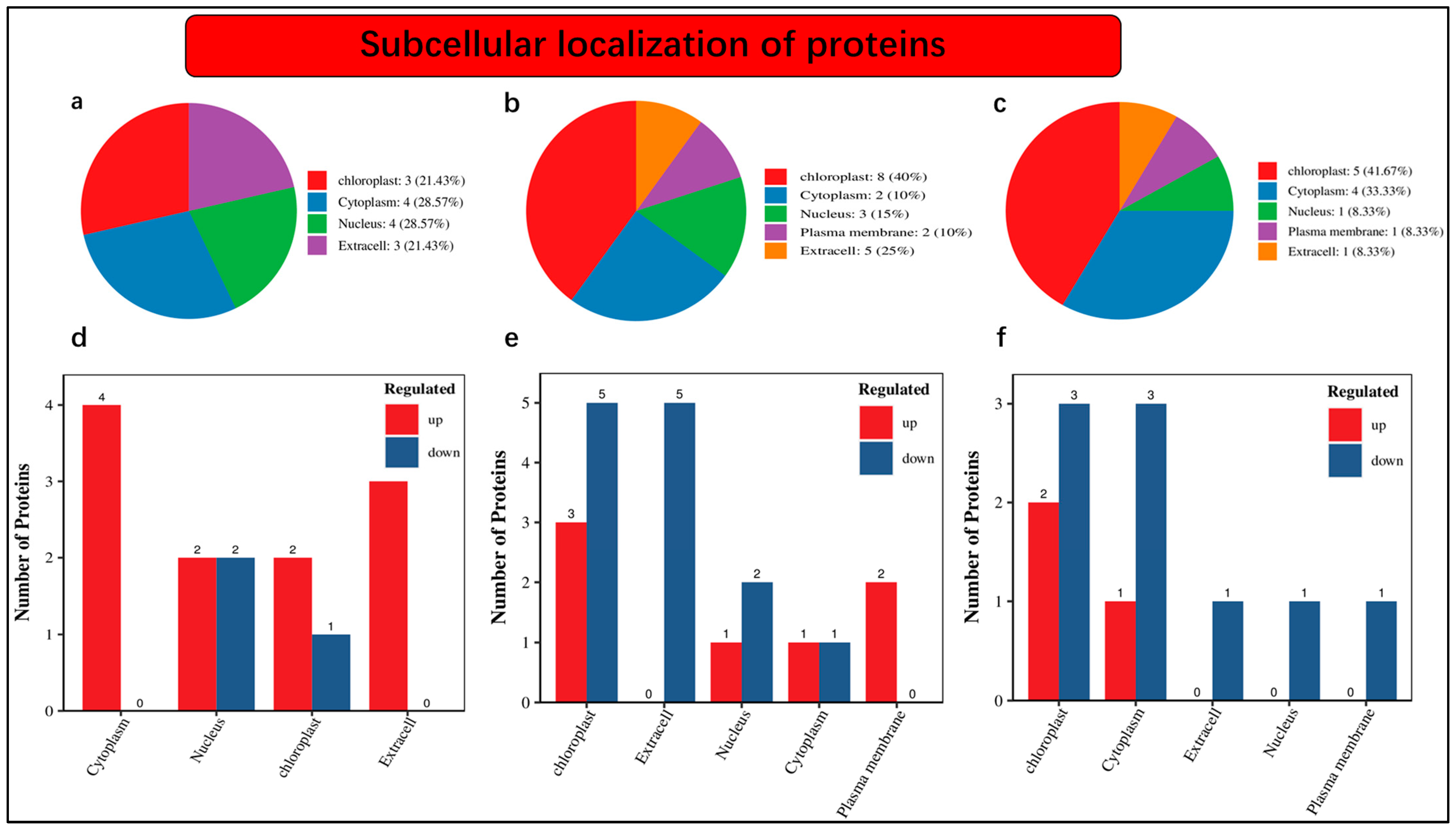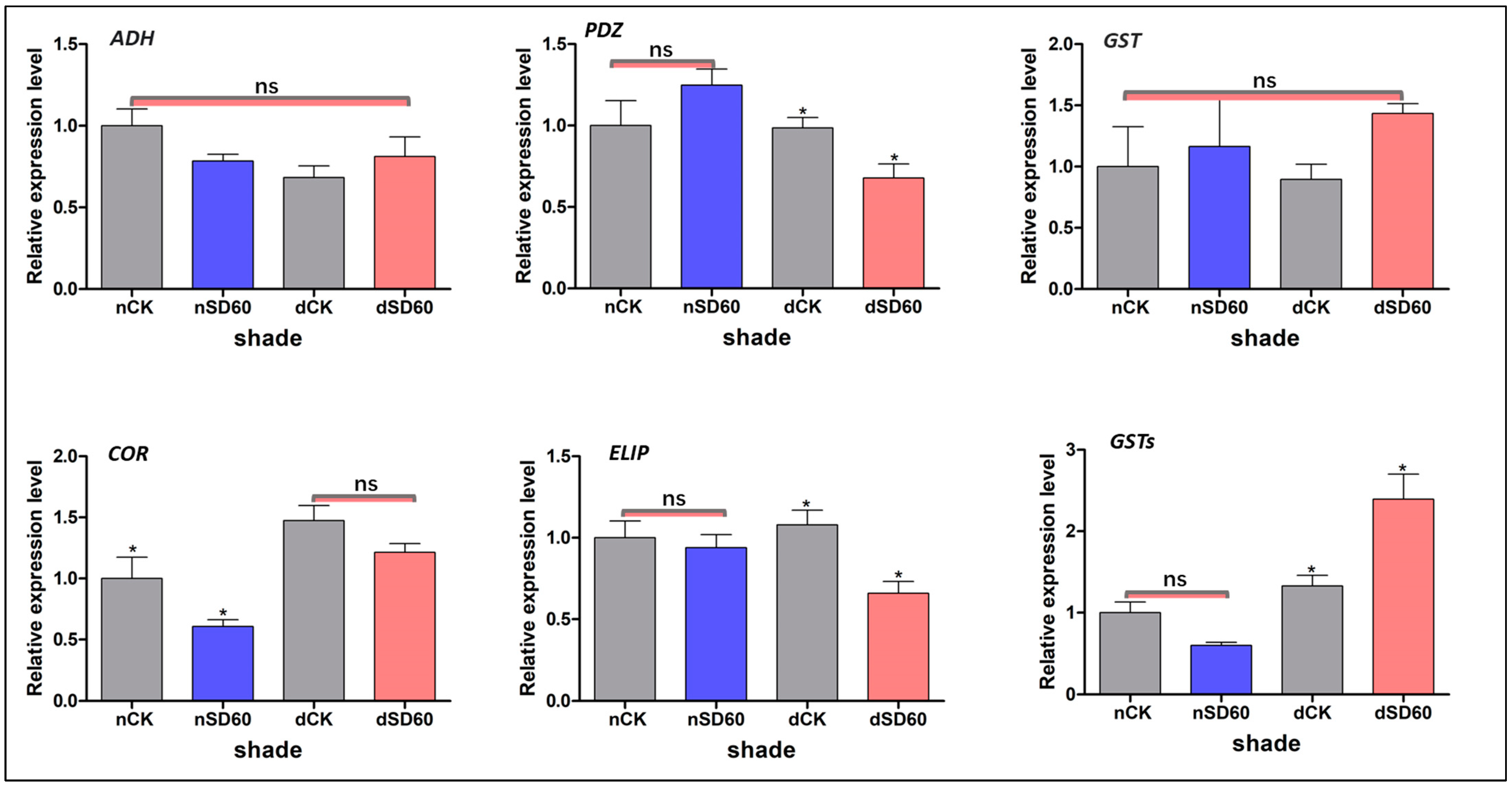Effect of Shading on Physiological Attributes and Proteomic Analysis of Tea during Low Temperatures
Abstract
:1. Introduction
2. Results
2.1. Effect of Shading on Soil Plant Analysis Development and Determination of Nitrogen Content in November and December during Low Temperatures
2.2. Effect of Shading on Photochemical Efficiency in November and December during Low Temperatures
2.3. TMT Proteomic Analysis of Tea Leaves
2.4. Effect of Shading on Differentially Accumulated Proteins in November and December during Low Temperatures
2.5. PCA, GO, and KEGG Enrichment Analysis of Differentially Accumulated Proteins in November and December during Low Temperatures
2.6. Subcellular Localization of Differentially Accumulated Proteins in November and December during Low Temperatures
2.7. Effect of Shading on Differentially Accumulated Proteins in November during Low Temperatures
2.8. Effect of Shading on Differentially Accumulated Proteins in December during Low Temperatures
2.9. Effect of Shading on Differentially Accumulated Proteins during Both November and December
2.10. qRT-PCR Authentication of Differentially Accumulated Proteins during November and December
3. Discussion
3.1. Effect of Shading on Physiological Attributes in November and December during Low Temperatures
3.2. Effect of Shading on Differentially Accumulated Proteins in November and December during Low Temperatures
4. Materials and Methods
4.1. Plant Material and Experimental Setup
4.2. Soil Plant Analysis Development and Determination of Nitrogen Content
4.3. Photochemical Efficiency Analysis
4.4. Protein Extraction and Trypsin Digestion
4.5. Fractionation and Identification
4.6. LC-MS/MS Analysis
4.7. Analysis of Proteomic Data
4.8. GO and KEGG Enrichment Analysis of Differentially Accumulated Proteins
4.9. Protein Abundance and Gene Expression Analysis Using qRT-PCR
4.10. Statistical Analysis
5. Conclusions
Supplementary Materials
Author Contributions
Funding
Data Availability Statement
Acknowledgments
Conflicts of Interest
Abbreviations
| SPAD | Soil Plant Development Analysis |
| Fv/Fm | Photochemical Efficiency |
| N | Nitrogen Content |
| DEPs | Differential Expressed Proteins |
| DAPs | Differential Accumulated Proteins |
| DHNs | Dehydrin |
| LEAs | Late-embryogenesis abundant proteins |
| TLPs | Thaumatin-like proteins |
| GSTs | Glutathione S-transferases |
| GAs | Gibberellin-regulated proteins |
| GPI | Glycosylphosphatidylinositol |
| PRPs | Proline-rich proteins |
| ELIP1 | Early light-induced protein 1 |
| SD0% | Control without shade or 0% shade. |
| SD60% | 60% of Shade Treatment. |
| TMT | Tandem mass tags |
References
- Shen, J.; Wang, S.; Sun, L.; Wang, Y.; Fan, K.; Li, C.; Wang, H.; Bi, C.; Zhang, F.; Ding, Z. Dynamic Changes in Metabolic and Lipidomic Profiles of Tea Plants during Drought Stress and Re-Watering. Front. Plant Sci. 2022, 13, 978531. [Google Scholar] [CrossRef] [PubMed]
- Mao, Y.; Li, H.; Wang, Y.; Fan, K.; Shen, J.; Zhang, J.; Han, X.; Song, Y.; Bi, C.; Sun, L.; et al. Low Temperature Response Index for Monitoring Freezing Injury of Tea Plant. Front. Plant Sci. 2023, 14, 1096490. [Google Scholar] [CrossRef]
- Zaman, S.; Shen, J.; Wang, S.; Song, D.; Wang, H.; Ding, S.; Pang, X.; Wang, M.; Sabir, I.A.; Wang, Y. Effect of Shading on Physiological Attributes and Comparative Transcriptome Analysis of Camellia Sinensis Cultivar Reveals Tolerance Mechanisms to Low Temperatures. Front. Plant Sci. 2023, 14, 1114988. [Google Scholar] [CrossRef]
- Li, Y.; Wang, X.; Ban, Q.; Zhu, X.; Jiang, C.; Wei, C.; Bennetzen, J.L. Comparative Transcriptomic Analysis Reveals Gene Expression Associated with Cold Adaptation in the Tea Plant Camellia Sinensis. BMC Genom. 2019, 20, 1–17. [Google Scholar] [CrossRef] [PubMed]
- Sergeant, K.; Kieffer, P.; Dommes, J.; Hausman, J.-F.; Renaut, J. Proteomic Changes in Leaves of Poplar Exposed to Both Cadmium and Low-Temperature. Environ. Exp. Bot. 2014, 106, 112–123. [Google Scholar] [CrossRef]
- Sharif, R.; Su, L.; Chen, X.; Qi, X. Hormonal Interactions Underlying Parthenocarpic Fruit Formation in Horticultural Crops. Hortic. Res. 2022, 9, 17. [Google Scholar] [CrossRef]
- Renaut, J.; Hausman, J.-F.; Wisniewski, M.E. Proteomics and Low-Temperature Studies: Bridging the Gap between Gene Expression and Metabolism. Physiol. Plant. 2006, 126, 97–109. [Google Scholar] [CrossRef]
- Dufoo-Hurtado, M.D.; Huerta-Ocampo, J.Á.; Barrera-Pacheco, A.; Barba de la Rosa, A.P.; Mercado-Silva, E.M. Low Temperature Conditioning of Garlic (Allium sativum L.) “Seed” Cloves Induces Alterations in Sprouts Proteome. Front. Plant Sci. 2015, 6, 332. [Google Scholar] [CrossRef]
- Gao, J.; Liu, Z.; Zhao, B.; Liu, P.; Zhang, J.-W. Physiological and Comparative Proteomic Analysis Provides New Insights into the Effects of Shade Stress in Maize (Zea mays L.). BMC Plant Biol. 2020, 20, 60. [Google Scholar] [CrossRef]
- Gao, F.; Ma, P.; Wu, Y.; Zhou, Y.; Zhang, G. Quantitative Proteomic Analysis of the Response to Cold Stress in Jojoba, a Tropical Woody Crop. Int. J. Mol. Sci. 2019, 20, 243. [Google Scholar] [CrossRef]
- Goharrizi, K.; Karami, S.; Basaki, T.; Dehnavi, M.; Nejat, M.A.; Momeni, M.M.; Meru, G. Transcriptomic and Proteomic Mechanisms Underlying Cold Tolerance in Plants. Biol. Plant. 2022, 66, 240–254. [Google Scholar] [CrossRef]
- Kausar, R.; Komatsu, S. Proteomic Approaches to Uncover Salt Stress Response Mechanisms in Crops. Int. J. Mol. Sci. 2023, 24, 518. [Google Scholar] [CrossRef] [PubMed]
- Hara, M. The Multifunctionality of Dehydrins: An Overview. Plant Signal. Behav. 2010, 5, 503–508. [Google Scholar] [CrossRef] [PubMed]
- Hundertmark, M.; Hincha, D.K. LEA (Late Embryogenesis Abundant) Proteins and Their Encoding Genes in Arabidopsis Thaliana. BMC Genom. 2008, 9, 118. [Google Scholar] [CrossRef] [PubMed]
- Wang, W.; Gao, T.; Chen, J.; Yang, J.; Huang, H.; Yu, Y. The Late Embryogenesis Abundant Gene Family in Tea Plant (Camellia sinensis): Genome-Wide Characterization and Expression Analysis in Response to Cold and Dehydration Stress. Plant Physiol. Biochem. 2019, 135, 277–286. [Google Scholar] [CrossRef] [PubMed]
- Zaman, S.; Shen, J.; Wang, S.; Wang, Y.; Ding, Z.; Song, D.; Wang, H.; Ding, S.; Pang, X.; Wang, M. Effects of Shading Nets on Reactive Oxygen Species Accumulation, Photosynthetic Changes, and Associated Physiochemical Attributes in Promoting Cold-Induced Damage in Camellia Sinensis (L.) Kuntze. Horticulturae 2022, 8, 637. [Google Scholar] [CrossRef]
- Zuther, E.; Lee, Y.P.; Erban, A.; Kopka, J.; Hincha, D.K. Natural Variation in Freezing Tolerance and Cold Acclimation Response in Arabidopsis Thaliana and Related Species. In Survival Strategies in Extreme Cold and Desiccation: Adaptation Mechanisms and Their Applications; Iwaya-Inoue, M., Sakurai, M., Uemura, M., Eds.; Advances in Experimental Medicine and Biology; Springer: Singapore, 2018; pp. 81–98. ISBN 9789811312441. [Google Scholar]
- Li, Z.; Jiang, H.; Yan, H.; Jiang, X.; Ma, Y.; Qin, Y. Carbon and Nitrogen Metabolism under Nitrogen Variation Affects Flavonoid Accumulation in the Leaves of Coreopsis Tinctoria. PeerJ 2021, 9, e12152. [Google Scholar] [CrossRef]
- Shao, C.; Jiao, H.; Chen, J.; Zhang, C.; Liu, J.; Chen, J.; Li, Y.; Huang, J.; Yang, B.; Liu, Z. Carbon and Nitrogen Metabolism Are Jointly Regulated During Shading in Roots and Leaves of Camellia Sinensis. Front. Plant Sci. 2022, 13, 894840. [Google Scholar] [CrossRef]
- Ochoa-Alfaro, A.E.; Rodríguez-Kessler, M.; Pérez-Morales, M.B.; Delgado-Sánchez, P.; Cuevas-Velazquez, C.L.; Gómez-Anduro, G.; Jiménez-Bremont, J.F. Functional Characterization of an Acidic SK3 Dehydrin Isolated from an Opuntiastreptacantha cDNA Library. Planta 2012, 235, 565–578. [Google Scholar] [CrossRef]
- Kovacs, D.; Kalmar, E.; Torok, Z.; Tompa, P. Chaperone Activity of ERD10 and ERD14, Two Disordered Stress-Related Plant Proteins. Plant Physiol. 2008, 147, 381–390. [Google Scholar] [CrossRef]
- Yang, Y.; He, M.; Zhu, Z.; Li, S.; Xu, Y.; Zhang, C.; Singer, S.D.; Wang, Y. Identification of the Dehydrin Gene Family from Grapevine Species and Analysis of Their Responsiveness to Various Forms of Abiotic and Biotic Stress. BMC Plant Biol. 2012, 12, 140. [Google Scholar] [CrossRef] [PubMed]
- Brini, F.; Yamamoto, A.; Jlaiel, L.; Takeda, S.; Hobo, T.; Dinh, H.Q.; Hattori, T.; Masmoudi, K.; Hanin, M. Pleiotropic Effects of the Wheat Dehydrin DHN-5 on Stress Responses in Arabidopsis. Plant Cell Physiol. 2011, 52, 676–688. [Google Scholar] [CrossRef] [PubMed]
- Battaglia, M.; Covarrubias, A.A. Late Embryogenesis Abundant (LEA) Proteins in Legumes. Front. Plant Sci. 2013, 4, 190. [Google Scholar] [CrossRef] [PubMed]
- Kosová, K.; Vítámvás, P.; Prášil, I.T. The Role of Dehydrins in Plant Response to Cold. Biol. Plant 2007, 51, 601–617. [Google Scholar] [CrossRef]
- Petre, B.; Major, I.; Rouhier, N.; Duplessis, S. Genome-Wide Analysis of Eukaryote Thaumatin-like Proteins (TLPs) with an Emphasis on Poplar. BMC Plant Biol. 2011, 11, 33. [Google Scholar] [CrossRef] [PubMed]
- Muoki, C.R.; Maritim, T.K.; Oluoch, W.A.; Kamunya, S.M.; Bore, J.K. Combating Climate Change in the Kenyan Tea Industry. Front. Plant Sci. 2020, 11, 339. [Google Scholar] [CrossRef] [PubMed]
- Singh, N.K.; Kumar, K.R.R.; Kumar, D.; Shukla, P.; Kirti, P.B. Characterization of a Pathogen Induced Thaumatin-like Protein Gene AdTLP from Arachis Diogoi, a Wild Peanut. PLoS ONE 2013, 8, e83963. [Google Scholar] [CrossRef]
- Kumar, S.; Trivedi, P.K. Glutathione S-Transferases: Role in Combating Abiotic Stresses Including Arsenic Detoxification in Plants. Front. Plant Sci. 2018, 9, 751. [Google Scholar] [CrossRef]
- Ding, N.; Wang, A.; Zhang, X.; Wu, Y.; Wang, R.; Cui, H.; Huang, R.; Luo, Y. Identification and Analysis of Glutathione S-Transferase Gene Family in Sweet Potato Reveal Divergent GST-Mediated Networks in Aboveground and Underground Tissues in Response to Abiotic Stresses. BMC Plant Biol. 2017, 17, 225. [Google Scholar] [CrossRef]
- Kim, S.-I.; Andaya, V.C.; Tai, T.H. Cold Sensitivity in Rice (Oryza sativa L.) Is Strongly Correlated with a Naturally Occurring I99V Mutation in the Multifunctional Glutathione Transferase Isoenzyme GSTZ2. Biochem. J. 2011, 435, 373–380. [Google Scholar] [CrossRef]
- Sappl, P.G.; Carroll, A.J.; Clifton, R.; Lister, R.; Whelan, J.; Harvey Millar, A.; Singh, K.B. The Arabidopsis Glutathione Transferase Gene Family Displays Complex Stress Regulation and Co-Silencing Multiple Genes Results in Altered Metabolic Sensitivity to Oxidative Stress. Plant J. 2009, 58, 53–68. [Google Scholar] [CrossRef] [PubMed]
- Qin, F.; Shinozaki, K.; Yamaguchi-Shinozaki, K. Achievements and Challenges in Understanding Plant Abiotic Stress Responses and Tolerance. Plant Cell Physiol. 2011, 52, 1569–1582. [Google Scholar] [CrossRef] [PubMed]
- Beihammer, G.; Maresch, D.; Altmann, F.; Strasser, R. Glycosylphosphatidylinositol-Anchor Synthesis in Plants: A Glycobiology Perspective. Front. Plant Sci. 2020, 11, 611188. [Google Scholar] [CrossRef] [PubMed]
- Tamirisa, S.; Vudem, D.R.; Khareedu, V.R. Overexpression of Pigeonpea Stress-Induced Cold and Drought Regulatory Gene (CcCDR) Confers Drought, Salt, and Cold Tolerance in Arabidopsis. J. Exp. Bot. 2014, 65, 4769–4781. [Google Scholar] [CrossRef] [PubMed]
- Sunitha, M.; Srinath, T.; Reddy, V.D.; Rao, K.V. Expression of Cold and Drought Regulatory Protein (CcCDR) of Pigeonpea Imparts Enhanced Tolerance to Major Abiotic Stresses in Transgenic Rice Plants. Planta 2017, 245, 1137–1148. [Google Scholar] [CrossRef] [PubMed]
- Rajasheker, G.; Nagaraju, M.; Varghese, R.P.; Jalaja, N.; Somanaboina, A.K.; Singam, P.; Ramakrishna, C.; Penna, S.; Sreenivasulu, N.; Kishor, P.B.K. Identification and Analysis of Proline-Rich Proteins and Hybrid Proline-Rich Proteins Super Family Genes from Sorghum Bicolor and Their Expression Patterns to Abiotic Stress and Zinc Stimuli. Front. Plant Sci. 2022, 13, 952732. [Google Scholar] [CrossRef]
- Fujino, K.; Obara, M.; Sato, K. Diversification of the Plant-Specific Hybrid Glycine-Rich Protein (HyGRP) Genes in Cereals. Front. Plant Sci. 2014, 5, 489. [Google Scholar] [CrossRef]
- Fowler, S.; Thomashow, M.F. Arabidopsis Transcriptome Profiling Indicates That Multiple Regulatory Pathways Are Activated during Cold Acclimation in Addition to the CBF Cold Response Pathway[W]. Plant Cell 2002, 14, 1675–1690. [Google Scholar] [CrossRef]
- Yang, H.; Li, J.; Yang, J.; Wang, H.; Zou, J.; He, J. Effects of Nitrogen Application Rate and Leaf Age on the Distribution Pattern of Leaf SPAD Readings in the Rice Canopy. PLoS ONE 2014, 9, e88421. [Google Scholar] [CrossRef]





| November (nCK_vs_nSD60) | ||||
|---|---|---|---|---|
| Accession | Gene | Fold Changes | Regulation | Description |
| A0A7J7HZN2 | HYC85_005495 | 1.7165 | increased | Dehydrin |
| A0A4S4ENN3 | TEA_026230 | 1.6532 | increased | Alcohol dehydrogenase |
| G0Z053 | un-Known | 1.5222 | increased | Late embryogenesis abundant protein |
| A0A7J7GMM6 | HYC85_021841 | 2.1332 | increased | Late embryogenesis abundant protein D-29-like |
| A0A4S4DFQ8 | TEA_023893 | 2.1248 | increased | Glutathione s transferase |
| A0A7J7GXX6 | HYC85_015860 | 0.6634 | decreased | Protein argonaute 16 |
| A2T1L9 | un-known | 2.0542 | increased | Thaumatin-like protein |
| A0A7J7I185 | HYC85_005506 | 1.8254 | increased | Nucleolar protein 6 |
| A0A4S4E6S2 | TEA_002616 | 0.6191 | decreased | Peptidase_S9_N domain-containing protein |
| A0A4S4ELM5 | TEA_011435 | 1.5961 | increased | LOV domain-containing protein |
| A0A4V3WME9 | TEA_012760 | 1.782 | increased | Cold and drought-regulated protein CORA-like |
| A0A7J7GQS1 | HYC85_020672 | 1.5366 | increased | Gibberellin-regulated protein |
| A0A7J7HLC6 | HYC85_010975 | 0.6654 | decreased | Pectinesterase |
| A0A7J7GQZ8 | HYC85_019506 | 1.6535 | increased | Proline-rich protein |
| December (dCK_vs_dSD60) | ||||
| A0A7J7HSW9 | HYC85_008796 | 0.6587 | decreased | Dehydrin |
| A0A7J7G8F3 | HYC85_024548 | 1.7761 | increased | Agglutinin domain-containing protein |
| A0A7J7GKR1 | HYC85_022566 | 1.6203 | increased | Lipoxygenase |
| A0A7J7HZN2 | HYC85_005495 | 0.4469 | decreased | Dehydrin |
| A0A4S4CXP2 | TEA_029801 | 0.6232 | decreased | Basic endochitinase-like |
| A0A7J7GMM6 | HYC85_021841 | 0.5414 | decreased | Late embryogenesis abundant protein D-29-like |
| A0A4V3WM41 | TEA_012013 | 1.5687 | increased | Agglutinin domain-containing protein |
| A0A7J7FX29 | HYC85_027665 | 0.6364 | increased | Late embryogenesis abundant protein D-29-like |
| A0A4S4EFX1 | TEA_008781 | 0.5375 | decreased | Early light-induced protein 1, chloroplast-like |
| A0A4S4DFQ8 | TEA_023893 | 0.6037 | decreased | Glutathione s transferase |
| A0A7J7GXX6 | HYC85_015860 | 1.6243 | increased | Protein argonaute 16 |
| A2T1L9 | un-known | 0.4454 | decreased | Thaumatin-like protein |
| A0A7J7I185 | HYC85_005506 | 2.5856 | increased | Nucleolar protein 6 |
| A0A7J7GAY3 | HYC85_024587 | 0.5295 | decreased | Pentatrico peptide repeat-containing protein |
| A0A4V3WME9 | TEA_012760 | 0.3446 | decreased | Cold and drought-regulated protein CORA-like |
| A0A7J7HX48 | HYC85_004657 | 0.6633 | decreased | Gibberellin-regulated protein |
| A0A7J7GQS1 | HYC85_020672 | 0.5496 | decreased | Gibberellin-regulated protein |
| A0A7J7GQZ8 | HYC85_019506 | 0.3688 | decreased | Proline-rich protein |
| A0A7J7FPU1 | HYC85_031015 | 1.6614 | increased | 1,3-beta-glucan synthase |
| A0A4S4EBQ7 | TEA_007391 | 1.6698 | increased | PGG domain-containing protein |
| November and December (nSD60_vs_dSD60) | ||||
| A0A2U8T4Y0 | un-known | 0.3747 | decreased | Ribulose bisphosphate carboxylase large chain (Fragment) |
| A0A7J7HZN2 | HYC85_005495 | 0.4556 | decreased | Dehydrin |
| G0Z053 | un-known | 0.6488 | decreased | Late embryogenesis abundant protein |
| A0A7J7GMM6 | HYC85_021841 | 0.4582 | decreased | Late embryogenesis abundant protein D-29-like |
| A0A7J7FX29 | HYC85_027665 | 0.6577 | decreased | Late embryogenesis abundant protein D-29-like |
| A0A4S4DFQ8 | TEA_023893 | 0.5286 | decreased | Glutathione transferase |
| A0A7J7HEP6 | HYC85_012990 | 1.5018 | increased | Amine oxidase |
| A2T1L9 | un-known | 0.5769 | decreased | Thaumatin-like protein |
| A0A4S4D849 | TEA_020688 | 1.6034 | increased | PDZ domain-containing protein |
| A0A7J7I7E8 | HYC85_002161 | 0.6024 | decreased | Transmembrane and coiled-coil domain-containing protein |
| A0A7J7HAZ1 | HYC85_011414 | 1.6267 | increased | COPII coated_ERV domain-containing protein |
| A0A7J7GQS1 | HYC85_020672 | 0.6555 | decreased | Gibberellin-regulated protein |
| November | December | |||
|---|---|---|---|---|
| Treatments | Shade Cloth Specification | Shade Level (%) | PAR (μmol·m−2·s−1) | PAR (μmol·m−2·s−1) |
| SD0 | None | 0% | 701 a | 260 a |
| SD60 | Black polyethylene net curtains | 60% | 263 b | 88 c |
Disclaimer/Publisher’s Note: The statements, opinions and data contained in all publications are solely those of the individual author(s) and contributor(s) and not of MDPI and/or the editor(s). MDPI and/or the editor(s) disclaim responsibility for any injury to people or property resulting from any ideas, methods, instructions or products referred to in the content. |
© 2023 by the authors. Licensee MDPI, Basel, Switzerland. This article is an open access article distributed under the terms and conditions of the Creative Commons Attribution (CC BY) license (https://creativecommons.org/licenses/by/4.0/).
Share and Cite
Zaman, S.; Shen, J.; Wang, S.; Song, D.; Wang, H.; Ding, S.; Pang, X.; Wang, M.; Wang, Y.; Ding, Z. Effect of Shading on Physiological Attributes and Proteomic Analysis of Tea during Low Temperatures. Plants 2024, 13, 63. https://doi.org/10.3390/plants13010063
Zaman S, Shen J, Wang S, Song D, Wang H, Ding S, Pang X, Wang M, Wang Y, Ding Z. Effect of Shading on Physiological Attributes and Proteomic Analysis of Tea during Low Temperatures. Plants. 2024; 13(1):63. https://doi.org/10.3390/plants13010063
Chicago/Turabian StyleZaman, Shah, Jiazhi Shen, Shuangshuang Wang, Dapeng Song, Hui Wang, Shibo Ding, Xu Pang, Mengqi Wang, Yu Wang, and Zhaotang Ding. 2024. "Effect of Shading on Physiological Attributes and Proteomic Analysis of Tea during Low Temperatures" Plants 13, no. 1: 63. https://doi.org/10.3390/plants13010063
APA StyleZaman, S., Shen, J., Wang, S., Song, D., Wang, H., Ding, S., Pang, X., Wang, M., Wang, Y., & Ding, Z. (2024). Effect of Shading on Physiological Attributes and Proteomic Analysis of Tea during Low Temperatures. Plants, 13(1), 63. https://doi.org/10.3390/plants13010063







